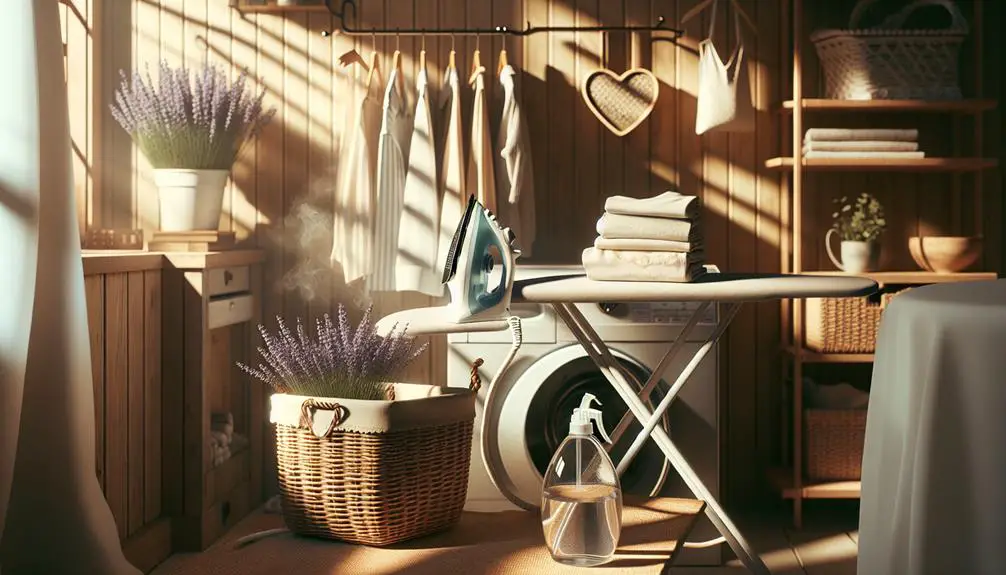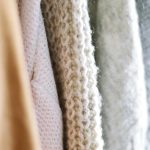I've always been a bit skeptical about those quick fixes for softening linen, but I recently stumbled upon a couple of methods that actually work wonders. Adding a cup of white vinegar during the rinse cycle, for instance, has turned my stiff linens into much softer, more comfortable fabrics. And let's not forget the magic of dryer balls; they truly cut down on drying time and help fluff up the linen. Now, I'm curious to explore other techniques. What if there's an even better method out there waiting to transform our linen experience?
Table of Contents
Key Takeaways
- Wash linen with a mixture of baking soda and gentle detergent to soften quickly.
- Use white vinegar in the rinse cycle for natural softening and pH balance restoration.
- Select a gentle wash cycle to prevent stressing the linen fibers, promoting softness.
- Include dryer balls in the drying cycle to agitate fabric and reduce drying time.
- Air dry linen partially, then finish with a low-heat dryer cycle for quick softening.
Understanding Linen's Texture
Linen's scratchy feel is all thanks to its natural fibers, coming straight from the flax plant. When I first got my linen sheets, they felt a bit stiff and itchy, but I learned that's just part of the charm. These unique textures are a shout-out from the flax plant itself, telling you, 'Hey, I'm natural, and I'm here to get cozier with every wash and wear.'
To soften up these sheets, I didn't just throw them in with my regular laundry. I'd to understand that the softening process is a bit like taming a wild beast – it requires patience and the right tools. Baking soda, water, and a splash of vinegar became my go-to. These aren't just ingredients for a science project; they're the holy trinity for softening linen fabric without damaging its natural beauty.
The thing is, softening linen sheets isn't about breaking them down. It's about letting them open up, relax, and show off their softer side. The more I learned about the flax plant and its fibers, the more I respected the process. It's not just washing; it's almost like nurturing, letting the fabric become the best version of itself.
The Washing Technique
After getting a grip on why linen feels the way it does, it's time to tackle how to properly wash it. I've learned that the secret to maintaining and even enhancing the softness of linen sheets lies in the washing technique. Here's the deal: washing linen in cool water with a gentle liquid detergent is crucial. This method is gentle on the fabric, ensuring that the integrity of the fibers isn't compromised, which is key to keeping those linen sheets feeling soft.
I also make it a point to avoid overcrowding the washing machine. Giving the linen enough space to move around ensures that each piece is thoroughly cleaned and agitated just right, which surprisingly contributes to its softness.
Following the manufacturer's instructions is a no-brainer for me. They often provide the optimal settings for washing linen to maintain its quality. And when it comes to drying, I'm all about natural drying methods. I've found that air-drying linen, especially in sunlight, can significantly preserve its texture and softness. Plus, washing my linen sheets before the first use and more often has been a game-changer in breaking down the fibers, gradually enhancing their softness over time.
Utilizing White Vinegar
Surprisingly, a simple pantry staple like white vinegar can work wonders in softening linen quickly. If you're like me, always on the hunt for eco-friendly and effective solutions, using white vinegar to soften linen is a game changer. This method isn't just about getting soft fabric; it's about understanding the science behind it.
White vinegar is my go-to because it cuts through the buildup of minerals and soap deposits that cling to linen fibers after washing. It's all about the acidity. Adding a bit of white vinegar to the rinse cycle helps break down these residues, making the linen fibers relax and soften. Plus, it helps restore the pH balance of the fabric. I've found that a soak overnight in a mixture of water and white vinegar does the trick for stubborn linens.
What's great is that it's not only about achieving soft linen quickly; it's also cost-effective and kind to the planet. So, if you're looking to ditch the harsh chemicals and switch to a more natural method, using white vinegar to soften linen is a brilliant move.
The Baking Soda Method
Alright, let's talk about how to soften linen with the baking soda method.
I've found that mixing baking soda in water and soaking the linen works wonders for making it feel softer.
It's all about the baking soda's magic of breaking down those tough fibers, and I'll show you how easy it's to apply this method.
Baking Soda Benefits
In our quest for softer linen, baking soda emerges as a game changer, effortlessly balancing water's pH levels during the wash. Here's why it's my go-to method:
- pH Level Balance: Baking soda naturally adjusts the pH level of water, ensuring fibers don't get too stiff.
- Residue Removal: It's ace at getting rid of any buildup on linen fibers, making them feel softer after each wash.
- Gradual Softening: Adding baking soda to each wash cycle works wonders, slowly but surely enhancing linen's softness.
- Natural and Cost-Effective: It's a natural, alkaline solution that breaks down stiff fibers without leaving a dent in my wallet.
Honestly, it's the simplest, most efficient way I've found to soften linen without any hassle.
Application Process Simplified
How do we quickly turn stiff linen soft with just baking soda and water? It's surprisingly simple and truly effective.
First off, dissolve some baking soda in water—this is your golden ticket. Then, soak your linen in this solution.
What's happening here? The baking soda's alkaline properties are getting to work, balancing the pH level of the water, which in turn makes the fabric softer.
This quick method effortlessly removes stiffness and roughness from your linen, giving you that softer fabric we're all after. And the best part? It's a natural way—no harsh chemicals involved.
It's not just about softening linen; it's about doing it in a way that's both effective and mindful of the materials we cherish.
Benefits of Dryer Balls
Let's talk about how dryer balls can seriously up your linen game by softening your sheets and saving energy. These little wonders are a game-changer for anyone looking to master the art of laundry, especially when it comes to linen. Here's why:
- Agitating Fabric to Soften Linen: Dryer balls work by agitating the fabric, breaking down stiffness and making your linen sheets feel softer with each tumble. Their repeated tumbling action is what gets the job done efficiently.
- Reducing Drying Time: They help reduce drying time by improving the air flow in the dryer. This not only saves energy but also means less time waiting for your sheets to dry.
- Eco-Friendly and Chemical-Free: Opting for dryer balls is choosing an eco-friendly, chemical-free method to care for your linens. Unlike traditional fabric softeners, they don't coat your sheets in chemicals, making them a safer option for the environment and your skin.
- Preventing Static Cling and Reducing Wrinkles: The natural tumbling action of dryer balls helps prevent static cling and reduces wrinkles, making your linen sheets smoother and ready to use straight out of the dryer.
In short, dryer balls are a simple, efficient way to soften linen, reduce drying time, and keep your sheets looking and feeling their best.
Sunlight's Natural Softening
Harnessing the power of sunlight, you can easily soften your linen, thanks to the sun's natural ability to break down fibers and reduce stiffness. I've found this method not only simple but incredibly effective. By hanging my linen items in direct sunlight, I've noticed a significant improvement in their texture and comfort. The UV rays work wonders, helping to relax the linen fibers, making them softer and more comfortable to use.
What's great about using sunlight for natural softening is it's not just about making your linen feel nicer; it's also about easing out those pesky wrinkles, giving your linen a smoother texture. I make it a point to air out my linen regularly in the sun, and it's remarkable how this practice helps maintain their softness and freshness over time.
Maintaining Softness Over Time
To keep my linen feeling soft and luxurious over time, I've adopted a few simple yet effective practices. Given that linen becomes softer with each wash and use, I've honed in on methods that enhance this natural fiber's plushness without compromising its quality. European linen, in particular, is known for its superior softness, and maintaining that comfort is key to its longevity and my relaxation.
Here's how I ensure my linen stays comfortable and soft:
- Gentle Wash Cycles: I always opt for gentle wash settings with mild detergent. This prevents the linen fabric from getting stressed and roughened up.
- Using Baking Soda: Adding a bit of baking soda to the wash cycle has been a game-changer. It naturally softens the linen without harsh chemicals.
- White Vinegar Rinse: A rinse with white vinegar in the fabric softener compartment acts as a natural softener, keeping the linen fibers soft and supple.
- Air Dry When Possible: I try to air dry my linen items as much as possible. The natural drying process helps retain the softness and avoids the harshness from a dryer.
Frequently Asked Questions
How Do You Soften Stiff Linen?
To soften stiff linen, I wash it with white vinegar or soak it in a vinegar-water mix overnight. Adding baking soda during the wash or ironing damp linen on high heat works wonders too.
How Do You Make Linen Super Soft?
To make linen super soft, I soak it overnight in a mix of vinegar and water. Additionally, I use a homemade spray of vinegar and water, and sometimes add baking soda to the wash.
Does 100% Linen Get Softer?
Yes, 100% linen does get softer over time. It naturally becomes more comfortable with each wash and use, without losing its durability. I've found that frequent laundering is key to speeding up the softening process.
How Long Does Linen Bedding Take to Soften?
I've found linen bedding usually takes a few washes, around 3-5, to really start softening up. But it's not just about the wash count; using the right method and care can speed up the process.
- The Use of Nonwovens in Construction and Civil Engineering - July 11, 2025
- The Use of Nonwovens in Construction and Civil Engineering - July 11, 2025
- The Use of Nonwovens in Construction and Civil Engineering - July 11, 2025





